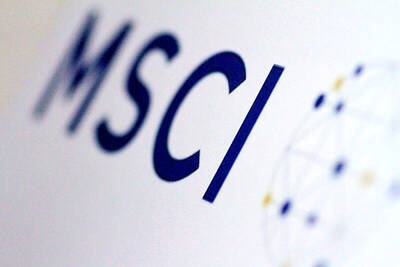Yageo Corp (國巨), the world’s biggest supplier of chip resistors, saw its shares fall by 8.61 percent yesterday, despite posting another record-breaking quarterly net profit as it hiked its prices due to supply constraints.
In the quarter that ended on March 31, Yageo made NT$4.26 billion (US$144 million), which was more than the company’s share capital of NT$3.51 billion. That represented a 4.3 times increase from NT$818.4 million in the first quarter of last year.
On a quarterly basis, net profit jumped 40 percent from NT$3.02 billion.
Earnings per share surged to NT$12.15 last quarter, compared with NT$1.62 a year earlier and NT$8.62 the previous quarter.
Gross margin climbed to a record high of 51.4 percent last quarter, mainly driven by rising contributions from high-end products for cars and industrial devices.
A persistent tight supply of multilayer ceramic capacitors (MLCC) and chip resistors also helped, Yageo said in a company statement on Tuesday.
The firm’s figures for last quarter beat some analysts’ expectations.
First Capital Management Inc (第一金投顧) yesterday said that Yageo’s gross margin beat its estimate of 46 percent and its earnings per share were also higher than the NT$10.13 it anticipated.
“The significant increase in last quarter’s net profit is primarily attributable to the newly unveiled pricing scheme for MLCC,” First Capital said in a research note.
MLCC accounted for 60 percent of Yageo’s revenue totaling NT$11.02 billion in the first quarter of this year, delivering a gross margin of about 60 percent, the investment consultancy said.
First Capital raised its revenue forecast for Yageo to NT$51.8 billion from NT$47.9 billion, in anticipation that the supply crunch would worsen after Japan’s Kyocera Corp announced its decision to stop supplying standard-type MLCC, it said.
This would prompt Yageo to start a new round of price hikes later this year, it added.
Yageo shares dropped to NT$584 yesterday in Taipei trading, but they have rallied about 65 percent since Jan. 2, when the stock closed at NT$354.
The firm is expected to boost capacity by between 25 and 30 percent this year to cope with robust demand, Taishin Securities Investment Advisory Co (台新投顧) said.
“The capacity expansion should help increase Yageo’s revenue this year,” Taishin Securities Investment Advisory said in a research note yesterday. “We expect supply of passive components to be tight during the second half of this year based on information from the supply chain.”
The investment advisory expects Yageo to make NT$49.63 billion in revenue this year, representing year-on-year growth of about 54 percent.
Yageo last month said it spent NT$12 billion in the final quarter of last year to expand its capacity to cope with rising demand.
Given its rosy profit outlook, Taishin Securities Investment Advisory and First Capital raised the target price of Yageo to NT$720 and NT$756, respectively, until December.

PERSISTENT RUMORS: Nvidia’s CEO said the firm is not in talks to sell AI chips to China, but he would welcome a change in US policy barring the activity Nvidia Corp CEO Jensen Huang (黃仁勳) said his company is not in discussions to sell its Blackwell artificial intelligence (AI) chips to Chinese firms, waving off speculation it is trying to engineer a return to the world’s largest semiconductor market. Huang, who arrived in Taiwan yesterday ahead of meetings with longtime partner Taiwan Semiconductor Manufacturing Co (TSMC, 台積電), took the opportunity to clarify recent comments about the US-China AI race. The Nvidia head caused a stir in an interview this week with the Financial Times, in which he was quoted as saying “China will win” the AI race. Huang yesterday said

Nissan Motor Co has agreed to sell its global headquarters in Yokohama for ¥97 billion (US$630 million) to a group sponsored by Taiwanese autoparts maker Minth Group (敏實集團), as the struggling automaker seeks to shore up its financial position. The acquisition is led by a special purchase company managed by KJR Management Ltd, a Japanese real-estate unit of private equity giant KKR & Co, people familiar with the matter said. KJR said it would act as asset manager together with Mizuho Real Estate Management Co. Nissan is undergoing a broad cost-cutting campaign by eliminating jobs and shuttering plants as it grapples

The Chinese government has issued guidance requiring new data center projects that have received any state funds to only use domestically made artificial intelligence (AI) chips, two sources familiar with the matter told Reuters. In recent weeks, Chinese regulatory authorities have ordered such data centers that are less than 30 percent complete to remove all installed foreign chips, or cancel plans to purchase them, while projects in a more advanced stage would be decided on a case-by-case basis, the sources said. The move could represent one of China’s most aggressive steps yet to eliminate foreign technology from its critical infrastructure amid a

MORE WEIGHT: The national weighting was raised in one index while holding steady in two others, while several companies rose or fell in prominence MSCI Inc, a global index provider, has raised Taiwan’s weighting in one of its major indices and left the country’s weighting unchanged in two other indices after a regular index review. In a statement released on Thursday, MSCI said it has upgraded Taiwan’s weighting in the MSCI All-Country World Index by 0.02 percentage points to 2.25 percent, while maintaining the weighting in the MSCI Emerging Markets Index, the most closely watched by foreign institutional investors, at 20.46 percent. Additionally, the index provider has left Taiwan’s weighting in the MSCI All-Country Asia ex-Japan Index unchanged at 23.15 percent. The latest index adjustments are to